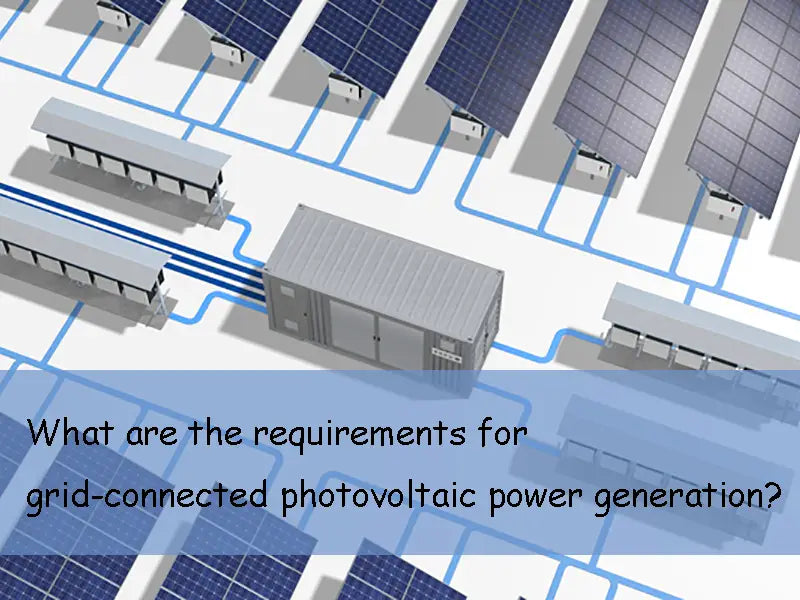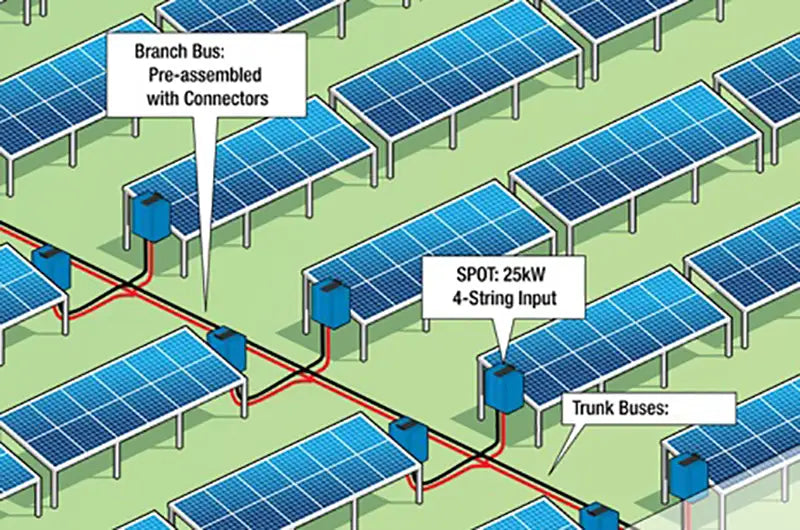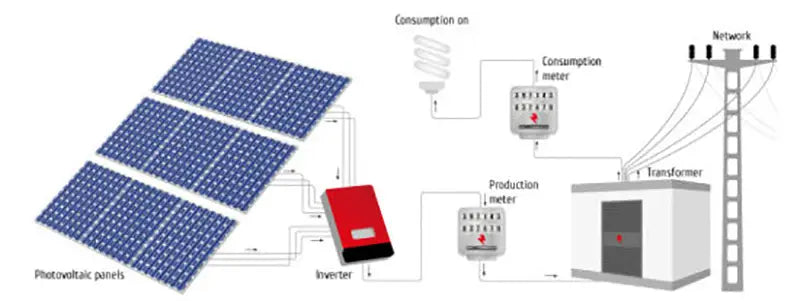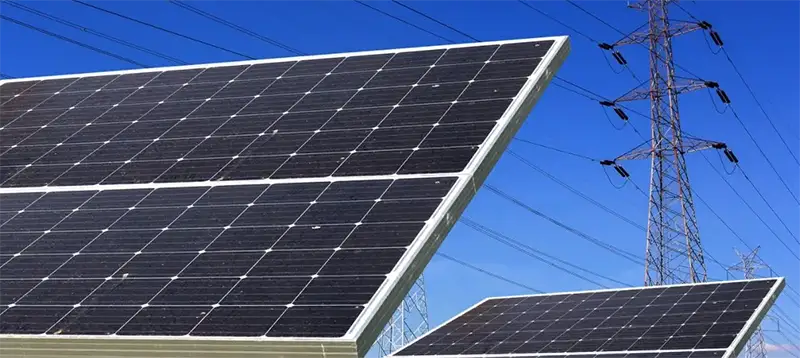
Main content:
- The impact of large-scale grid-connected photovoltaic power generation on the power grid
- Interaction between the development of electrified railways and the grid-connected operation of photovoltaic power generation
- The impact of electrified railways on grid-connected photovoltaic power generation
- Measures to improve the color sound of traction load
- The power supply requirements of the electrified railway to the grid-connected photovoltaic power generation
- Interaction between high-speed railway and grid-connected photovoltaic power station
- Technical requirements for grid-connected photovoltaic power generation of large-scale photovoltaic power stations
1. The impact of large-scale grid-connected photovoltaic power generation on the power grid
The grid-connected photovoltaic power generation is volatile and intermittent. Therefore, the grid-connected operation of large-scale photovoltaic power generation will affect the voltage level, short-circuit current level, system stability, peak regulation and frequency regulation, system reserve capacity, power quality, etc. of the power system. varying degrees of influence.
(1) Influence of grid-connected photovoltaic power generation on grid voltage level
Since the solar resource-rich areas in my country are far from the load center, large-scale photovoltaic power generation cannot be accommodated locally and needs to be transported to the load center through a long-distance transmission network. When the output of photovoltaic power generation is high, the remote transmission of a large amount of photovoltaic power will often cause the line voltage drop to be too large, the voltage stability of the local power grid will be affected, and the stability margin will be reduced.
(2) The influence of grid-connected photovoltaic power generation on the short-circuit current level of the grid
A few days ago, the domestic grid-connected photovoltaic power generation inverters all use the current source control mode. The research shows that under this control mode, the short-circuit capacity of the bus node near the photovoltaic power station is quite different when the photovoltaic power station is generating and not generating electricity. The photovoltaic power station has a great contribution to the short-circuit current of the nearby nodes, and the short-circuit current provided is mainly the active component. , whose magnitude mainly depends on the active power before the fault and the bus voltage on the AC side of the inverter during the fault.
(3) The impact of grid-connected photovoltaic power generation on the power quality of the grid
Due to the volatility and intermittent characteristics of photovoltaic power generation, the output power of grid-connected photovoltaic power generation fluctuates, resulting in power quality problems such as grid voltage fluctuation and flicker. However, the power electronic frequency conversion equipment widely used in photovoltaic power plants will bring harmonic problems.
(4) Influence of grid-connected photovoltaic power generation on grid stability
When the penetration rate of photovoltaic power generation in the power grid is large, the access of photovoltaic power generation will have an impact on the original power flow distribution of the power grid, the transmission power of the line and the inertia of the entire system. Therefore, after large-scale photovoltaic power generation is connected to the grid, the temporary stability of the grid will change.
(5) Influence of grid-connected photovoltaic power generation on grid dispatching operation and grid reserve capacity
Because the regional load characteristics are often inconsistent with the output characteristics of photovoltaic power generation, it will increase the difficulty of grid scheduling after large-scale photovoltaic power generation is connected to the grid. To additional economic investment, increase the operating costs of the power grid.

2. Interaction between the development of electrified railways and the grid-connected operation of photovoltaic power generation
2.1 The impact of electrified railways on grid-connected photovoltaic power generation
The rectifier electric locomotive used in the electrified railway is a kind of asymmetric load, which has the characteristics of non-linearity, impact and short-time concentrated load. When the traction power supply system will inject harmonic current and negative sequence current components into the power system.
(1) Harm of negative sequence current and voltage to power system. For the generator in the system, when the three-phase current is unbalanced, the output of the generator will drop, causing additional vibration and loss, resulting in additional heat and energy loss, and the local high temperature caused by this will reduce the metal material of the rotor parts. strength and coil insulation strength.
The negative sequence voltage is very unfavorable to the operation of the asynchronous motor. When a small negative sequence voltage is added to the asynchronous motor, it will cause a large negative sequence current and negative sequence reverse electromagnetic torque, which directly affects the efficiency and safety of the asynchronous motor. Reliable operation. Due to the asymmetry of the three-phase current caused by the negative sequence current, one of the three-phase currents of the power transformer has the largest current, and the rated output of the transformer cannot be effectively exerted. When the negative sequence current flows through the transmission line, the negative sequence current does not actually do work, but only causes power loss, which increases the network loss and reduces the transmission capacity of the transmission line.
In addition, the negative sequence current will also interfere with the negative sequence parameter starting elements of the relay protection and automatic devices, causing them to malfunction frequently. In order to eliminate the influence of negative sequence on the relay protection, it is necessary to increase the complexity of the relay protection device and reduce the reliability.
(2) Harm of harmonic current to power system. The influence of harmonics on the power system can be roughly divided into two aspects: the excessive harmonic current flowing into the electrical equipment will cause the load to overheat, and may form a resonance phenomenon under certain conditions; The controlled equipment and meter measurement will cause control errors and measurement errors, and the accuracy of the color sound.
Harmonics will cause additional loss and heating of the generator, causing additional vibration, noise and harmonic overvoltage, resulting in the aging of the stator winding insulation of the asynchronous motor, partial discharge of cables and other equipment, overheating, insulation aging, and shortened life, resulting in damage; interference; Relay protection and automatic devices cause protection malfunction and affect the safe and stable operation of the system.
The existence of the distributed capacitance to ground and phase-to-phase of each element in the system at the harmonic frequency makes the power system form a complex network composed of capacitance, reactance and resistance, plus the large capacitive elements such as compensation capacitors that originally exist in the system The interaction with electromagnetic voltage transformers, transformers and other nonlinear magnetic components will cause harmonic resonance or harmonic-sensitive points in the local system. Therefore, the harmonics injected into the system by high-speed rail loads may cause resonance and harmonic amplification.
(3) Impact characteristics. Although the average load of traction load is not large, the impact load is large, and it has obvious characteristics of time concentration and regional concentration.

2.2 Measures to improve the color sound of traction load
(1) The traction transformers of each traction substation are connected by commutation, and three-phase and two-phase balance transformers are used.
(2) For ordinary electric locomotives, a thyristor switching third-order resonance capacitor compensation circuit is set on the traction winding of the locomotive.
(3) Switch the tertiary resonance capacitor compensation circuit on the power supply arm of the traction substation.
(4) The railway dispatching department strives to distribute the load evenly between the two power supply arms of the traction substation.
(5) Install compensation devices such as static reactive power compensators in traction substations.
2.3 The power supply requirements of the electrified railway to the grid-connected photovoltaic power generation
(1) Traction substations of ordinary electrified railways are generally connected to 110kV power system, and traction stations of high-speed railways are connected to higher voltage levels, 220kV and 330kV systems. The higher the voltage level of the grid-connected photovoltaic power generation system, the greater the short-circuit capacity, the stronger the system load and harmonic tolerance, the smaller the power loss of the grid-connected photovoltaic power generation traction power supply system, and the higher the power supply reliability. costs will increase accordingly.
(2) Power supply mode for grid-connected photovoltaic power generation: electrified railway traction generally uses two independent power supplies, and the two power supplies are standby for each other.
(3) At present, the 110kV and 220kV power grids are de-looped and layered in most areas in China, and the electrified railway is only for PCC.

2.4 Interaction between high-speed railway and grid-connected photovoltaic power station
(1) The power quality of grid-connected photovoltaic power generation. As far as the current technical level is concerned, the harmonic and negative sequence components injected into the grid by electrified railways are far greater than those of photovoltaic power plants. In areas where electrified railways are concentrated, power quality problems are more prominent, and power quality exceeding the standard often occurs.
The grid-connected photovoltaic power generation adopts a high-power inverter well network. The harmonics and negative sequence current generated by the high-speed railway traction load in the power system will interfere with the power control of the inverter, resulting in damage to the output power of the inverter. As a result, the control fails, and the photovoltaic power station cannot be connected to the grid normally.
Before the grid-connected photovoltaic power generation of electrified railway is connected to people, it is necessary to check the harmonic and negative sequence component problems caused by it, so as to avoid the electrified railway from affecting the normal operation of grid-connected photovoltaic power generation. At the same time, photovoltaic power stations are also required to have sufficient anti-harmonic Wave voltage unbalance ability to avoid events similar to electrified rail access bringing down wind farms.
The grid-connected photovoltaic power generation will inject a certain harmonic current into the grid. Before the grid-connected photovoltaic power generation is connected to the grid, special research on power quality must be conducted. When the photovoltaic power generation is connected to the grid for trial operation, the power quality test must be carried out, and the photovoltaic power generation can only be connected to the grid after passing the test. Two methods of special research and grid connection test are adopted to ensure that the grid-connected photovoltaic power generation will not cause the power quality of the grid to exceed the standard and avoid adverse effects.
(2) Power supply reliability of grid-connected photovoltaic power generation. Electrified railways require high-reliability power supply to ensure their safe operation. Electrified railway traction generally uses two independent power supplies, and the two power supplies are hot backups for each other. When the running line fails and stops operation, it can automatically switch to another line for operation. .
Through transient stability analysis, it is shown that the integration of photovoltaic power generation into the grid does not deteriorate the stability of Qinghai power grid, and will not directly affect the reliability of power supply of electrified railways.

3. Technical requirements for grid-connected photovoltaic power generation of large-scale photovoltaic power stations
my country's power grid structure is relatively weak. Much grid-connected photovoltaic power generation under construction or planning are located in weak areas or at the end of the power grid. In addition, photovoltaic power generation is fluctuating and intermittent. some adverse effects. In order to ensure the safe and stable movement of the grid and photovoltaic power stations after large-scale photovoltaic power generation is connected to the grid, it is necessary to formulate technical standards for the grid-connected photovoltaic power generation and access system. To this end, the State Grid Corporation of China promulgated and implemented the "State Grid Corporation's Technical Regulations on Connecting Photovoltaic Power Plants to Power Grids" in July 2009, which put forward technical requirements for photovoltaic power plants connected to the power system for grid-connected photovoltaic power generation.

Read more: Contents of technical requirements for wind power grid connection